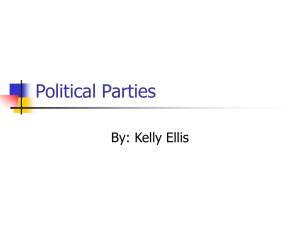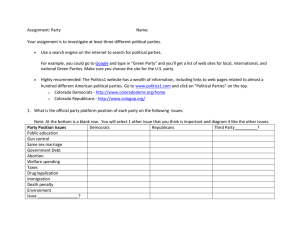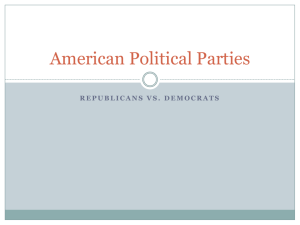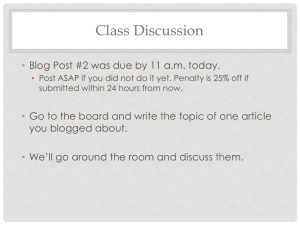Political Parties Web Quest Name: Part 1: Donkeys and Elephants
advertisement
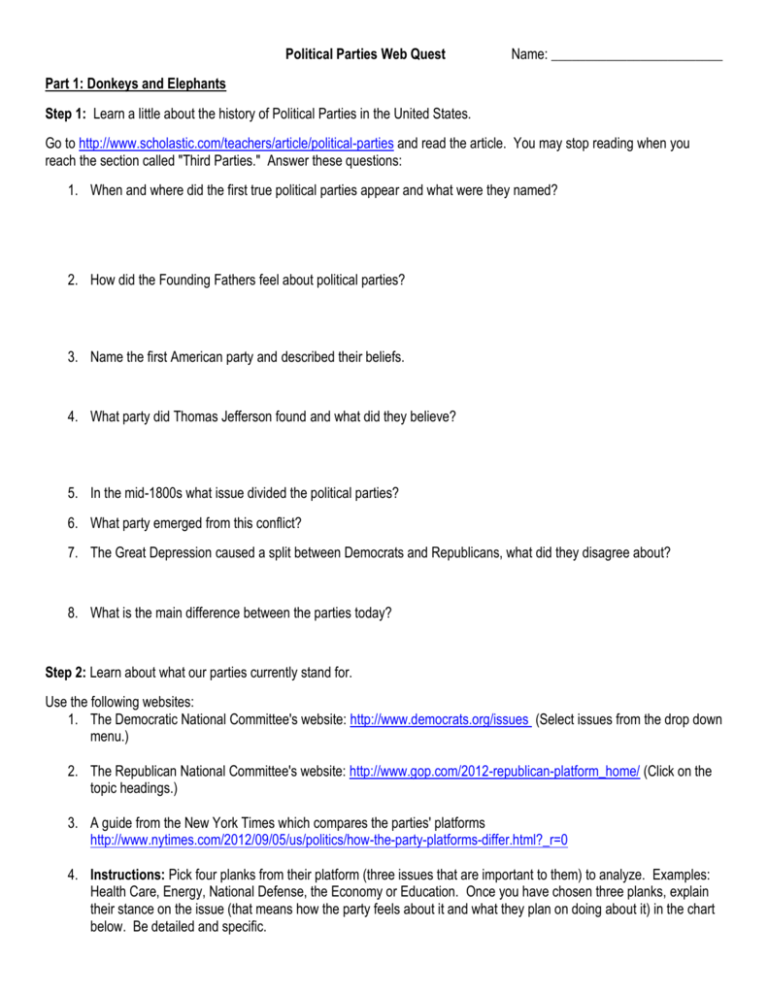
Political Parties Web Quest Name: _________________________ Part 1: Donkeys and Elephants Step 1: Learn a little about the history of Political Parties in the United States. Go to http://www.scholastic.com/teachers/article/political-parties and read the article. You may stop reading when you reach the section called "Third Parties." Answer these questions: 1. When and where did the first true political parties appear and what were they named? 2. How did the Founding Fathers feel about political parties? 3. Name the first American party and described their beliefs. 4. What party did Thomas Jefferson found and what did they believe? 5. In the mid-1800s what issue divided the political parties? 6. What party emerged from this conflict? 7. The Great Depression caused a split between Democrats and Republicans, what did they disagree about? 8. What is the main difference between the parties today? Step 2: Learn about what our parties currently stand for. Use the following websites: 1. The Democratic National Committee's website: http://www.democrats.org/issues (Select issues from the drop down menu.) 2. The Republican National Committee's website: http://www.gop.com/2012-republican-platform_home/ (Click on the topic headings.) 3. A guide from the New York Times which compares the parties' platforms http://www.nytimes.com/2012/09/05/us/politics/how-the-party-platforms-differ.html?_r=0 4. Instructions: Pick four planks from their platform (three issues that are important to them) to analyze. Examples: Health Care, Energy, National Defense, the Economy or Education. Once you have chosen three planks, explain their stance on the issue (that means how the party feels about it and what they plan on doing about it) in the chart below. Be detailed and specific. Democrat Republican 1. 1. 2. 2. 3. 3. 4. 4. Part 2: Three’s a Crowd Link not working Step 1: Through independent research, answer the following: . Answer these questions: 1. List the five nationally recognized third parties: 2. How do third parties affect our political system? 3. Why don’t third parties usually succeed? 4. What do they have to do to get federal funding? Step 2: Find third parties at: http://www.politics1.com/parties.htm. Instructions: Scroll down the website until you see third parties. Read about FIVE (5) third parties. The best way to find a party’s beliefs or stances is by going to their website: CLICK ON THE NAME OF THE PARTY (It’s red and bold) to go to their site. Look for a section on their website titled either “PLATFORM,” “ABOUT US,” or “WHAT WE STAND FOR.” Some extreme party sites might be blocked. Fill out information about them in this chart. Party Name List a few of their beliefs (platform) 1. Constitution Party 2. Green Party 3. Libertarian Party Place the five parties you researched on the political spectrum. This might be tough, do the best you can! Democrats Republicans *Read before you move on. A note from the teacher: The next part of this assignment involves your personal beliefs. I will not share any of this with anyone else, so please be honest with all of your answers. While taking these quizzes if you do not understand a term or question – look it up! You are almost done. Part 3: Where do I fit? 5. Plot your location on this chart by drawing a star. QUIZ 1: World's Smallest Political Quiz 1. Go to: http://www.theadvocates.org/quiz and take this short quiz. Your PERSONAL issues Score is _____ Libertarian Your ECONOMIC issues Score is _____ Left Liberal 100 2. According to your answers, the political group that agrees with you most is... ________________________ Right Conservative Moderate 80 80 60 3. On personal and social issues this group feels: _______ _____________________________________________ _____________________________________________ 4. On economic issues this group feels: _______________ _____________________________________________ _____________________________________________ 100 60 Populist 40 40 20 20 0

